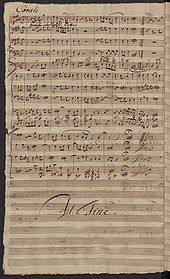Liebster Gott, wenn werd ich sterben? BWV 8
Liebster Gott, wenn werd ich sterben? (lit. 'Dearest God, when will I die?'), BWV 8, is a church cantata by Johann Sebastian Bach. He composed the chorale cantata in Leipzig for the 16th Sunday after Trinity and first performed it on 24 September 1724. It is based on the hymn by Caspar Neumann, and its setting by Daniel Vetter.
| Liebster Gott, wenn werd ich sterben? BWV 8 | |
|---|---|
| Chorale cantata by Johann Sebastian Bach | |
 Opening chorale copied c 1750[1] | |
| Occasion | 16th Sunday after Trinity |
| Based on | "Liebster Gott, wann werd ich sterben" (setting by Daniel Vetter) |
| Performed | 24 September 1724: Leipzig |
| Movements | 6 |
| Vocal | SATB choir and soloists |
| Instrumental |
|
History and text
Bach composed the cantata in his second year as Thomaskantor in Leipzig for the 16th Sunday after Trinity.[2][3] It is based on the hymn of the same name by Caspar Neumann, part of Bach's second cantata cycle, planned as a cycle of chorale cantatas. Daniel Vetter, organist at the Nikolaikirche in Leipzig, composed the hymn tune for Neumann's hymn, Zahn No. 6634, before 1695.[4][5] Vetter's four-part setting of the hymn was commissioned for the funeral of the cantor Jakob Wilisius: it was published in 1713 as Part II of his book of chorales Kirch- und Haus-Ergötzlichkeit.[2][4][6]
The prescribed readings for the Sunday were from the Epistle to the Ephesians, praying for the strengthening of faith in the congregation of Ephesus (Ephesians 3:13–21), and from the Gospel of Luke, the raising from the dead of the young man from Nain (Luke 7:11–17). Bach first performed the cantata on 24 September 1724.[2][7]
Scoring and structure
The piece is scored for horn, flauto traverso, two oboes d'amore, strings (violins, violas and basso continuo), vocal soloists and choir.[8] It is in six movements, in E major unless otherwise noted:
| No. | Title | Text | Type | Vocal | Winds | Strings | Key | Time |
|---|---|---|---|---|---|---|---|---|
| 1 | Liebster Gott, wenn werd ich sterben? | Chorus | SATB | 1 flauto traverso, 2 oboe d'amore, natural horn (col soprano) | 2 violins, 1 viola | E major | 12/8 | |
| 2 | Was willst du dich, mein Geist, entsetzen | Aria | tenor | 1 oboe d'amore | C-sharp minor | 3/4 | ||
| 3 | Zwar fühlt mein schwaches Herz | Recitative | alto | 2 violins, 1 viola | ||||
| 4 | Doch weichet, ihr tollen, vergeblichen Sorgen! | Aria | bass | 1 flauto traverso | 2 violins, 1 viola | A major | ||
| 5 | Behalte nur, o Welt, das Meine! | Recitative | soprano | 1 flauto traverso | 2 violins, 1 viola | |||
| 6 | Herrscher über Tod und Leben | Chorale | SATB | 1 flauto transverso (col soprano), 1 oboe d'amore (col soprano), 1 oboe d'amore (coll'alto) 1 natural horn (col soprano) | 1 violin (col soprano), 1 violin (coll'alto), 1 viola (col tenore) | E major |
Music

The opening chorus is a gapped chorale setting of the tune. The alto, tenor, and bass voices sing free counterpoint, while the sopranos sing the chorale unadorned in long notes. Philipp Spitta described the sound of this movement as a "church-yard full of flowers in the springtime". As Alfred Dürr comments, the chorus, with instrumental ensemble of high obbligato flute, two oboes d'amore and plucked arpeggios, presents "a sublime vision of the hour of death".[2][10]
The tenor aria is characterized by continued tones of the death knell and string pizzicato in the accompaniment, and an eloquent duet between the vocal line and the oboe d'amore. The following alto recitative "brings forth a bit of the terror of death", in contrast with the joyous bass aria in "jig tempo" that follows. After a clipped soprano recitative, the chorus and orchestra unite in the final chorale, ending the cantata.[2][10][11] Christoph Wolff notes that "the texturally transparent and rhythmically vibrant setting" of the closing chorale is informed by the treatment of the opening chorus. More generally Emil Platen and Wolff have observed that when Bach adapted or borrowed chorales from more recent composers such as Vopelius or Vetter, he composed in a more fashionable and melodic style.[12][13]
In 1998 the authenticity of the closing chorale of BWV 8 was placed in doubt, when it was labelled as "spurious" in the second edition of the Bach-Werke-Verzeichnis.[14] In 2003, however, Michael Maul and Peter Wollny resolved some uncertainty by establishing that the main unidentified copyist for BWV 8—linked to C.F. Doles (Thomaskantor 1756-1789)—was Carl Friedrich Barth, born in 1734, the son of a merchant from Glauchau. Barth became a chorister at the Thomasschule in 1746, where he was picked out by Bach for his skills in Latin to become music prefect. After leading performances at the Thomaskirche and Nikolaikirche, he enrolled at the University of Leipzig in 1757 to study philosophy and theology. In 1770 he was appointed as a Cantor in Borna, where he died in 1813.[1][15][16]
None of these searches of the early 21st century about who copied the cantata in the middle of the 18th century have however any relation whatsoever with the reason why its closing chorale, BWV 8/6, is listed as a spurious work in the third Anhang of the 1998 edition of the Bach-Werke-Verzeichnis: the chorale is qualified as a spurious Bach-composition while its four-part setting was composed by Daniel Vetter, published in 1713 (see above), after which it was copied, with some revisions, by Bach, in his 1724 cantata, a decade before Barth arrived in Leipzig.[17][18][19]
Other version
An alternative version of the cantata in D major is also extant, likely first performed in September 1747.[20][2] Several minor changes to the instrumentation were also implemented; for example, in the first movement the two oboe parts are given to concertante violins, and in the bass aria, the oboe d'amore is used colla parte with the flute. Both variants have been recorded: the aria by Ton Koopman with Klaus Mertens as the bass soloist and the Amsterdam Baroque Orchestra, and the chorus by Koopman's pupil Masaaki Suzuki and the Bach Collegium Japan in addition to the full cantata in E major.[21]
Recordings
Muziekweb lists several recordings of the cantata:[21]
- Amsterdam Baroque Orchestra & Choir, Ton Koopman. Challenge Classics 2000, CC72212.
- Bach Collegium Japan, Masaaki Suzuki. BIS 2004, CD1351.
- Collegium Vocale Gent, Philippe Herreweghe. Harmonia Mundi France 1998, HMC901659.
- Leonhardt-Consort, Choir of King's College, Cambridge, Gustav Leonhardt. Teldec 1971.
- Bach-Collegium Stuttgart, Helmuth Rilling. Hänssler Classic 1979.
- Monteverdi Choir, English Baroque Soloists, John Eliot Gardiner. Soli Deo Gloria 2000, 104.
- Münchener Bach-Chor, Münchener Bach-Orchester, Karl Richter. Bach Cantatas Vol. 4 – Sundays after Trinity. Archiv Produktion 1959.
- The Bach Ensemble, Joshua Rifkin. Decca L'Oiseau-Lyre 1988, 455 706–2.
- American Bach Soloists, Jeffrey Thomas. Koch, 1992.
References
- Maul, Michael; Wollny, Peter (2003). "Quellenkundliches zu Bach-Aufführungen in Köthen, Ronneburg und Leipzig zwischen 1720 und 1760". Bach-Jahrbuch (in German). Neue Bachgesellschaft. 89: 97–141.
- Dürr, Alfred; Jones, Richard D. P. (2006). The Cantatas of J.S. Bach. Oxford University Press. pp. 550–553. ISBN 0-19-929776-2.
- Schulze, Hans-Joachim (2006). "Foreword of Cantata BWV 8". Die Bach-Kantaten. Einführungen zu sämtlichen Kantaten Johann Sebastian Bachs, Leipzig (PDF). Translated by David Kosviner. Carus-Verlag.
- Zahn, Johannes (1891). Die Melodien der deutschen evangelischen Kirchenlieder (in German). IV. Bertelsmann. p. 130.
- "Liebster Gott, wenn werd ich sterben BWV 8/6". Bach Digital. 22 May 2019.
- Vetter, Daniel (1713). Musicalische Kirch- und Hauß-Ergötzlichkeit (in German). 2. No. 91. OCLC 857536916.
- "Liebster Gott, wenn werd ich sterben [1st version] BWV 8.1". Bach Digital. 8 April 2020.
- "BWV 8 Liebster Gott, wenn werd ich sterben?". University of Alberta. Retrieved 3 November 2013.
- Boomhower, Daniel F. (2014). "C. P. E. Bach Sources at the Library of Congress". Notes. Music Library Association. 70: 597–660. For biographical details of the copyist Carl Friedrich Barth (1734-1813), see pages 621–622.
- Smith, Craig. "BWV 8". Emmanuel Music. Retrieved 28 May 2013.
- Dahn, Luke, ed. (2019). "BWV 8.6 (=BWV 8/6)". bach-chorales.com. Retrieved 28 June 2020.
- Wolff, Christoph (2020). Bach's Musical Universe: The Composer and His Work. W. W. Norton & Company. p. 141.
- Platen, Emil (1976). "Zur Echtheit einiger Choralsätze Johann Sebastian Bachs". Bach-Jahrbuch (in German). Neue Bachgesellschaft. 61: 50–62.
- Dürr, Alfred; Kobayashi, Yoshitake, eds. (1998). Bach-Werke-Verzeichnis. Kleine Ausgabe (BWV 2a). Nach Wolfgang Schmieders 2. Ausgabe (in German). Breitkopf & Härtel. ISBN 9783765102493.CS1 maint: date and year (link) A third edition of BWV is promised in 2020, eds. C. Blanken, C. Wolff & P. Wollny, Bach-Archiv Leipzig.
- Bärwald, Manuel (2016). "Recent Research Developments". In Leaver, Robin A. (ed.). The Routledge Research Companion to Johann Sebastian Bach. Routledge. pp. 480–481. ISBN 9781409417903.
- Maul, Michael (2018). Bach’s Famous Choir: The Saint Thomas School in Leipzig, 1212–1804. Woodbridge. ISBN 9781783271696.
- Dürr, Alfred; Kobayashi, Yoshitake, eds. (1998). Bach Werke Verzeichnis: Kleine Ausgabe – Nach der von Wolfgang Schmieder vorgelegten 2. Ausgabe [Bach Works Catalogue: Small Edition – After Wolfgang Schmieder's 2nd edition] (in German). Kirsten Beißwenger (collaborator). (BWV2a ed.). Breitkopf & Härtel. p. 468. ISBN 9783765102493. Preface in English and German.
- Platen, Emil (1976). "Zur Echtheit einiger Choralsätze Johann Sebastian Bachs" [On the authenticity of some of Johann Sebastian Bach's chorale settings]. In Schulze, Hans-Joachim; Wolff, Christoph (eds.). Bach-Jahrbuch 1975 [Bach Yearbook 1975]. Bach-Jahrbuch (in German). 61. Neue Bachgesellschaft. Evangelische Verlagsanstalt. pp. 50–62. doi:10.13141/bjb.v1975.
- Dahn, Luke (2018). "So how many Bach four–part chorales are there?". bach-chorales.com. Retrieved 28 June 2020.
- "Liebster Gott, wenn werd ich sterben [2nd version] BWV 8.2". Bach Digital. 8 April 2020.
- "Cantate voor soli (4), koor en orkest BWV.8, 'Liebster Gott, wenn werd ich sterben?'". Muziekweb. Retrieved 28 June 2020.
External links
- Liebster Gott, wenn werd ich sterben? BWV 8: Scores at the International Music Score Library Project (IMSLP)
- BWV 8 Liebster Gott, wenn werd ich sterben? English translation, University of Vermont
- Meinrad Walter: Sterben, Betrübnis, Dank / Drei dramatische Themen in J. S. Bachs musikalischer Sprache des Glaubens bachkantaten.ch
- Dellal, Pamela. "BWV 8 – "Liebster Gott, wenn werd ich sterben?"". Emmanuel Music. Retrieved 22 August 2016.
